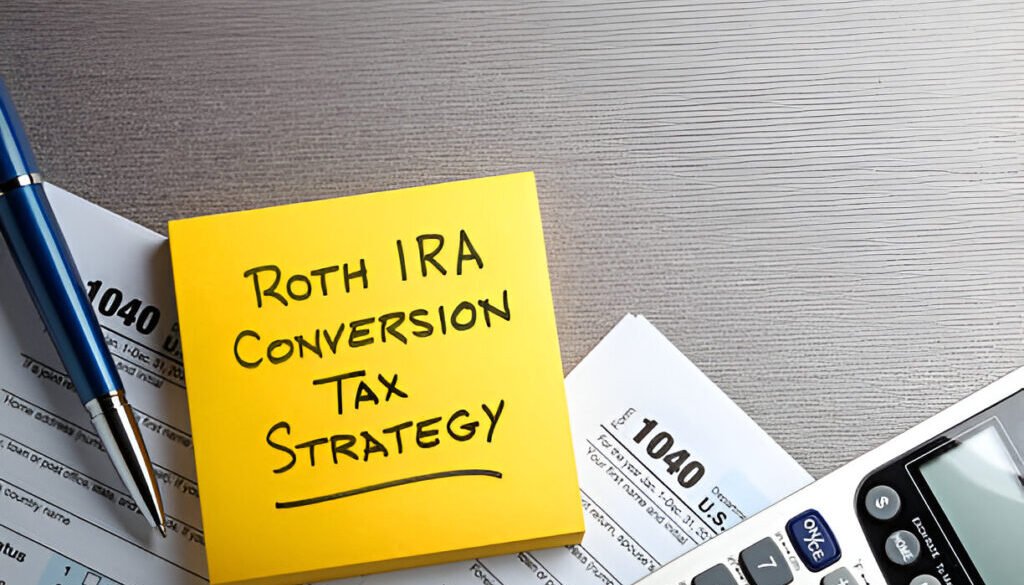How Much Tax Do you pay on a Roth IRA conversion?
You’re staring at your traditional IRA balance, daydreaming about converting it to a Roth, when that nagging tax question hits: “How Much Tax Do you pay on a Roth IRA conversion?”
Table of Contents
Let’s cut through the confusion. Roth IRA conversions aren’t complicated once you understand the tax mechanics, but getting it wrong can mean thousands in unexpected taxes or missed opportunities.
I’ve guided hundreds of clients through Roth IRA conversions, and I’ll walk you through exactly how the taxes work, when conversions make sense, and the calculation methods that could save you serious money.
The answer isn’t one-size-fits-all – your tax bracket, timing, and conversion amount all play crucial roles in determining your Roth IRA conversion tax bill.
But first, let’s talk about the question that probably brought you here…
What is a Roth IRA conversion?
A Roth IRA conversion is simply moving money from your traditional IRA (or 401(k)) into a Roth IRA. It’s not creating a new investment—it’s changing how your existing retirement savings will be taxed.
When you convert, you’re essentially saying, “I’ll pay taxes now so I don’t have to pay them later.” You’ll owe income tax on the amount you convert in the year you make the conversion.
Think of it like this: Your traditional IRA is a tax-deferred account (you got a tax break when you put the money in), while a Roth IRA is a tax-free account (you pay taxes upfront, but never again).
The actual process is pretty straightforward:
- Open a Roth IRA if you don’t already have one
- Request a transfer from your traditional IRA provider
- Pay the tax bill when you file your taxe
Benefits of converting traditional IRAs to Roth IRAs
The big payoff for converting to a Roth IRA? Tax-free growth and withdrawals forever. But that’s not all:
- Zero RMDs: Unlike traditional IRAs, Roth IRAs don’t have required minimum distributions at age 73. Your money can keep growing if you don’t need it.
- Tax diversification: Having both traditional and Roth accounts gives you flexibility in retirement to manage your tax bracket.
- Legacy planning gold: Your heirs will thank you. They’ll inherit the Roth IRA tax-free, though they’ll need to empty it within 10 years.
- Tax-free earnings: Every dollar your investments earn stays yours—no sharing with Uncle Sam.
- Protection from future tax hikes: Worried taxes might go up? A conversion locks in today’s rates.
- Early access to contributions: You can take out converted amounts penalty-free after 5 years.
Key differences between traditional and Roth IRAs
| Feature | Traditional IRA | Roth IRA |
| Tax on contributions | Tax-deductible (upfront tax break) | No tax deduction (after-tax dollars) |
| Tax on withdrawals | Taxed as ordinary income | Tax-free (if qualified) |
| Required Minimum Distributions | Yes, starting at age 73 | None during owner’s lifetime |
| Early withdrawal penalties | 10% penalty before age 59½ (with exceptions) | 10% penalty on earnings only before 59½ (with exceptions) |
| Income limits for contributions | No income limits | Yes, phases out at higher incomes |
| Tax impact on Social Security | Withdrawals may make Social Security taxable | No impact on Social Security taxation |
Who should consider a Roth conversion
Roth conversions aren’t for everyone. You’re a good candidate if:
- You believe your tax rate will be higher in retirement than it is now
- You can pay the conversion tax with money outside your retirement accounts
- You have several years before retirement to recoup the tax cost
- You’re in a temporarily lower tax bracket (job change, sabbatical, etc.)
- You want to leave tax-free money to your heirs
- Your traditional IRA has declined in value (convert more shares at a lower tax cost)
- You’ve got cash reserves to cover the tax bill without dipping into the IRA itself
On the flip side, skip the conversion if you’ll need the money soon, expect to be in a much lower tax bracket in retirement, or don’t have the cash to pay the conversion tax.
Remember, timing matters. The sweet spot is often when your income is lower than usual but before you start collecting Social Security.
How Much Tax Do you pay on a Roth IRA conversion?
Tax Implications of Roth IRA Conversions
A. The basic tax principle: paying taxes on pre-tax contributions
The heart of a Roth IRA conversion tax bill is pretty straightforward: you’re paying taxes now on money you haven’t paid taxes on yet. That’s it.
Think about your traditional IRA or 401(k). Remember how those contributions went in before taxes? That was great for reducing your taxable income back then. But now with a Roth conversion, Uncle Sam wants his cut.
When you convert, you’re essentially saying: “I’ll pay my tax bill now instead of during retirement.” The entire amount you convert
from pre-tax accounts gets added to your taxable income for the year.
For example, if you convert $50,000 from your traditional IRA to a Roth IRA, that $50,000 gets stacked on top of your regular income. Making $80,000 from your job? Now the IRS sees you making $130,000 this year.
B. How converted amounts are added to your taxable income
Your Roth conversion doesn’t sit in its own special tax category. It’s just regular income as far as the IRS is concerned.
This means the conversion amount gets piled on top of your wages, interest, dividends, capital gains, and any other income you report on your tax return. And yes, this can push you into higher tax brackets.
The timing matters too. When you complete your conversion affects which tax year it counts toward. Convert on December 31, 2025, and that’s 2025 income. Wait until January 1, 2026, and it’s next year’s problem (or benefit, depending on your tax situation).
This stacking effect is why many people choose to spread conversions across multiple years. Breaking a $300,000 conversion into $60,000 chunks over five years could keep you in lower tax brackets each year.
C. Understanding your marginal tax rate and its impact
Your marginal tax rate is crucial for figuring out the true cost of your Roth conversion.
The U.S. tax system is progressive, meaning different portions of your income get taxed at different rates. When you add a Roth conversion on top, you’ll pay taxes on that amount at your highest marginal rate—and possibly push yourself into even higher brackets.
For 2025, the federal tax brackets look like this:
| Tax Rate | Single Filers | Married Filing Jointly |
| 10% | $0-$11,600 | $0-$23,200 |
| 12% | $11,601-$47,150 | $23,201-$94,300 |
| 22% | $47,151-$100,525 | $94,301-$201,050 |
| 24% | $100,526-$191,950 | $201,051-$383,900 |
| 32% | $191,951-$243,725 | $383,901-$487,450 |
| 35% | $243,726-$609,350 | $487,451-$731,200 |
| 37% | Over $609,350 | Over $731,200 |
A $50,000 conversion might get taxed at 22%, 24%, or even multiple rates if it straddles bracket thresholds.
D. State taxes on Roth conversions
Federal taxes aren’t your only concern with a Roth conversion. Unless you live in one of the nine states with no income tax, you’ll likely owe state taxes too.
State tax rates vary dramatically:
| Tax Treatment | States |
| No income tax | Alaska, Florida, Nevada, New Hampshire, South Dakota, Tennessee, Texas, Washington, Wyoming |
| Low tax rates (under 5%) | Arizona, Colorado, Illinois, Indiana, Michigan, North Dakota, Pennsylvania |
| High tax rates (over 9%) | California, Hawaii, Minnesota, New Jersey, New York, Oregon |
Living in California? Your Roth conversion could trigger an additional 13.3% tax at the highest marginal rate. That’s on top of federal taxes!
Some states also have special retirement income exemptions that might exclude IRA distributions, but these typically don’t apply to conversions.
E. Medicare surtax considerations for high-income earners
If your income is already high, a Roth conversion could trigger an additional 3.8% Net Investment Income Tax (NIIT).
This Medicare surtax kicks in when your modified adjusted gross income exceeds:
- $200,000 for single filers
- $250,000 for married filing jointly
While the conversion itself isn’t investment income, it raises your MAGI, potentially subjecting your investment income to this extra tax.
Additionally, high-income Medicare recipients pay higher premiums through Income-Related Monthly Adjustment Amounts (IRMAA). A large conversion could bump you into a higher IRMAA bracket for the following year, increasing your Medicare Part B and D premiums.
These premium increases can add thousands to your effective conversion cost—an often overlooked aspect of Roth conversion planning.
Calculating Your Conversion Tax Bill

Step-by-step method to estimate your tax liability
Converting your traditional IRA to a Roth isn’t complicated, but you need to know what you’re getting into tax-wise. Here’s how to figure out what you’ll owe:
- Add up the total amount you want to convert
- Determine your current taxable income before the conversion
- Combine these numbers to see what tax bracket(s) the conversion will fall into
- Calculate the additional tax based on those brackets
The key thing to remember? Every dollar you convert gets added to your taxable income for the year. So a $50,000 conversion when you already make $80,000 means you’re now being taxed as if you earned $130,000.
Using tax brackets to determine your conversion costs
Tax brackets are crucial for understanding your conversion costs. For 2025, here’s what you’re looking at:
| Tax Rate | Single Filers | Married Filing Jointly |
| 10% | $0-$11,600 | $0-$23,200 |
| 12% | $11,601-$47,150 | $23,201-$94,300 |
| 22% | $47,151-$100,525 | $94,301-$201,050 |
| 24% | $100,526-$191,950 | $201,051-$383,900 |
| 32% | $191,951-$243,725 | $383,901-$487,450 |
| 35% | $243,726-$609,350 | $487,451-$731,200 |
| 37% | $609,351+ | $731,201+ |
The smart approach? Convert just enough to “fill up” your current tax bracket without pushing into the next one. This strategy helps minimize your tax hit.
Pro-rata rule explained for partially taxable conversions
If you’ve made non-deductible contributions to your traditional IRA, you might think only the pre-tax portions get taxed during conversion. Nice try—the IRS is way ahead of you.
The pro-rata rule means you can’t cherry-pick which funds to convert. Instead, the IRS views all your IRA assets as one big pool. The taxable portion is calculated like this:
Taxable Percentage = (Pre-tax IRA Balance ÷ Total IRA Balance) × 100
So if 80% of your IRA balance consists of pre-tax contributions and earnings, then 80% of your conversion amount will be taxable—regardless of which account you pull from.
Tax calculation examples at different income levels
Nothing makes this clearer than seeing some real numbers. Let’s break it down:
Example 1: Lower Income
Sarah makes $40,000 annually and converts $20,000.
- Before conversion: In the 12% bracket
- After adding $20,000: Still mostly in 12%, with only about $13,000 spilling into the 22% bracket
- Approximate tax cost: $2,400 (12% on $7,000 + 22% on $13,000)
Example 2: Middle Income
Mark earns $95,000 and converts $50,000.
- Before conversion: Near the top of the 22% bracket
- After adding $50,000: Pushes well into the 24% bracket
- Approximate tax cost: $11,500 (22% on $5,500 + 24% on $44,500)
Example 3: Higher Income
Jessica’s income is $200,000 and she converts $100,000.
- Before conversion: In the 32% bracket
- After adding $100,000: Spans both 32% and 35% brackets
- Approximate tax cost: $33,250 (32% on $43,725 + 35% on $56,275)
The takeaway? The higher your income before conversion, the more your Roth conversion gets taxed at those top-tier rates.
Strategies to Minimize Conversion Taxes

A. Timing your conversion to lower your tax burden
Smart timing can save you a bundle when converting to a Roth IRA. December isn’t actually the best month for this financial move. Consider making your conversion early in the tax year (January or February) to give yourself maximum flexibility.
Why does this matter? If the market tanks after your conversion, you’ll have until October 15th of the following year to “undo” it through recharacterization. Plus, early-year conversions give you more time to gather funds to pay that tax bill.
Keep an eye on tax bracket thresholds too. Converting just enough to “fill up” your current bracket without spilling into the next one can be genius. For example, if you’re $20,000 away from the next tax bracket, converting exactly that amount maximizes your conversion while keeping your tax rate lower.
B. Multi-year conversion strategy to spread out tax liability
Why swallow the whole tax pill at once when you can split it into smaller doses?
Breaking up your traditional IRA into several annual conversions can keep you in lower tax brackets each year. This strategy, often called “bracket filling,” works especially well for large accounts.
Here’s what it might look like:
| Year | Amount Converted | Tax Bracket | Estimated Tax |
| 2025 | $40,000 | 22% | $8,800 |
| 2026 | $40,000 | 22% | $8,800 |
| 2027 | $40,000 | 22% | $8,800 |
Rather than converting $120,000 all at once (potentially pushing you into the 32% bracket), you’d save thousands by spreading it out.
C. Using tax deductions to offset conversion income
The key to a smarter conversion? Pair it with hefty deductions in the same tax year.
Some powerful options to consider:
- Bunch your charitable contributions into conversion years
- Accelerate business expenses if you’re self-employed
- Time major medical expenses with your conversion if possible
- Maximize retirement plan contributions to reduce taxable income
For example, donating $10,000 to charity in the same year you convert $30,000 effectively reduces your taxable conversion to just $20,000.
D. Converting during lower income years
Life transitions create perfect windows for Roth conversions. These “tax valleys” might include:
- Years between retirement and taking Social Security
- Sabbaticals or career breaks
- Business loss years (if you’re self-employed)
- Periods of part-time work
A couple retiring at 62 but delaying Social Security until 70 has eight golden years for conversions at potentially much lower tax rates.
Even market downturns create opportunities. Converting when your investments have temporarily lost value means paying taxes on a smaller amount while getting the same number of shares into your tax-free Roth account.
Special Tax Considerations
Impact on other tax credits and deductions
When you convert traditional IRA funds to a Roth, it’s not just about paying that immediate tax bill. The conversion can throw a wrench into your entire tax situation for the year.
Your adjusted gross income (AGI) will jump—sometimes dramatically—and this ripple effect touches everything from child tax credits to student loan interest deductions. Many tax benefits phase out as your income climbs, so you might suddenly find yourself ineligible for deductions you’ve counted on for years.
Take the American Opportunity Tax Credit for college expenses. A Roth conversion could push your income above the $90,000 threshold (for single filers), wiping out a credit worth up to $2,500. That’s real money!
Or consider these common deductions that might disappear:
- Student loan interest deduction
- Medical expense deduction (threshold increases)
- Itemized deduction limitations
- Child tax credit phase-outs
The higher your conversion amount, the bigger the impact. Sometimes it makes sense to spread conversions across multiple tax years to minimize these effects.
Tax consequences for early withdrawals after conversion
Think the money’s all yours after conversion? Not so fast. The IRS has some strings attached.
If you tap into your newly converted Roth IRA funds before hitting 59½, you could face a 10% early withdrawal penalty on any earnings (not your contributions). Many folks mistakenly believe the conversion magically makes everything penalty-free. It doesn’t.
Here’s the tricky part: when you withdraw from a Roth IRA, the IRS considers your contributions to come out first (tax-free), then your converted amounts, and finally your earnings. This ordering rule actually works in your favor.
But the converted amounts follow special rules. You’ll pay that 10% penalty if you withdraw converted funds within five years of conversion—unless you qualify for an exception like:
- First-time home purchase (up to $10,000)
- Qualified education expenses
- Birth or adoption expenses
- Certain medical expenses
The five-year clock starts January 1st of the year you make the conversion. And yes, each conversion has its own five-year clock!
Handling the 5-year rule for tax-free withdrawals
The infamous 5-year rule trips up even seasoned investors. Actually, there are two different 5-year rules for Roth IRAs, and mixing them up can cost you big time.
The first 5-year rule applies to earnings. No matter your age, your Roth IRA must be open for at least five tax years before earnings come out tax-free. This clock starts January 1st of the year you make your first contribution to any Roth IRA.
The second 5-year rule—the one I mentioned above—applies specifically to conversions. Each conversion has its own 5-year waiting period before you can touch those funds penalty-free if you’re under 59½.
Confused yet? Here’s a practical example:
You’re 45 and convert $50,000 from a traditional IRA to a Roth in July 2025. In 2027, you need $20,000. You can withdraw it without penalties only if it counts as original contributions. If it’s part of your converted amount, you’ll face that 10% penalty because you’re under 59½ and within the 5-year window.
Keeping solid records of all your contributions and conversions isn’t just good practice—it’s essential for navigating these rules.
Required minimum distribution (RMD) implications
One of the sweetest perks of Roth conversion? Escaping RMDs for good.
Traditional IRAs force you to start taking distributions at age 73 (as of 2025), whether you need the money or not. These RMDs are fully taxable and can push you into higher tax brackets during retirement.
Converting to a Roth eliminates this headache entirely. Roth IRAs have no RMDs during the original owner’s lifetime. Your money can grow tax-free until you need it—or forever, if you’re leaving it to heirs.
But timing matters. If you’re already subject to RMDs when you convert, you must take your required distribution for the current year before converting the remainder. The IRS won’t let you convert your way out of an RMD that’s already due.
For many retirees, this RMD freedom is the primary motivation for conversion, especially when they:
- Have significant other income sources
- Want to minimize taxes for heirs
- Expect to be in the same or higher tax bracket during retirement
- Want to preserve tax-free growth potential for decades
Recharacterization limitations after the Tax Cuts and Jobs Act
Remember the good old days when you could hit the “undo” button on Roth conversions? Those days are gone.
Before the Tax Cuts and Jobs Act of 2017, if you converted to a Roth and then regretted it—maybe the market tanked, or your tax situation changed—you could “recharacterize” the conversion back to a traditional IRA up until your tax filing deadline (including extensions).
This strategy let people convert in January, watch how their investments performed, and recharacterize by October 15th of the following year if things went sideways. It was a nearly risk-free way to test the Roth waters.
Now? Once you convert, you’re locked in. The tax bill comes due no matter what happens to those investments afterward.
This makes careful planning absolutely critical. You need to be confident about:
- Your current and future tax brackets
- Your ability to pay the conversion tax from non-retirement funds
- Your long-term financial needs
- Market timing (to some extent)
Without the recharacterization safety net, many advisors recommend converting smaller amounts over several years rather than going all-in at once. This approach helps manage the tax hit and reduces the risk of buyer’s remorse.
Working with Tax Professionals

A. When to consult a financial advisor or tax specialist
Roth IRA conversions aren’t something you want to wing. Sure, some people handle these conversions solo, but bringing in a pro makes sense in several situations:
- Your conversion involves significant money (typically over $50,000)
- You have multiple retirement accounts with different tax treatments
- Your income fluctuates year to year, making tax planning tricky
- You’re unsure how the conversion might push you into a higher tax bracket
- You have other major financial events happening the same year (home sale, business income, etc.)
The stakes are high – mess up a large conversion and you could pay thousands in unnecessary taxes. A good advisor costs money, but they’ll likely save you more than their fee.
B. Essential questions to ask your tax professional
When you sit down with your tax pro, come prepared with these questions:
- “How will this conversion impact my tax bracket this year?”
- “Should I spread this conversion over multiple tax years?”
- “What’s my estimated tax bill from this conversion?”
- “Are there strategies to reduce my conversion tax burden?”
- “How should I pay the taxes – from my IRA or from separate funds?”
- “What timing would be most tax-advantageous for my situation?”
- “Will this conversion affect other tax situations like Medicare premiums or Social Security taxation?”
Don’t be shy about asking these questions – you’re paying for their expertise, after all.
C. Documentation needed for tax filing after conversion
Keep your paperwork straight or the IRS might come knocking. Here’s what you’ll need:
- Form 1099-R from your IRA custodian showing the distribution
- Form 5498 showing the conversion deposit into your Roth IRA
- Records of any non-deductible contributions (Form 8606 from previous years)
- Documentation of any withholding for taxes during the conversion
- Previous tax returns (especially if you’ve made non-deductible contributions)
Organize these documents before tax season hits. Your future self will thank you when April rolls around and you’re not frantically digging through file cabinets.
Remember to keep these records for at least 7 years after filing. The IRS has questions? You’ve got answers.
Converting traditional retirement funds to a Roth IRA can be a strategic financial move, but understanding the tax implications is crucial for making informed decisions. The amount you’ll pay depends on your current tax bracket, the conversion amount, and your overall financial situation. By implementing strategies like partial conversions, timing your conversion thoughtfully, and offsetting the tax burden with deductions, you can potentially reduce the immediate tax impact while setting yourself up for tax-free growth in retirement.
Before making any Roth IRA conversion decisions, consider consulting with a qualified tax professional who can analyze your specific circumstances. They can help you develop a personalized conversion strategy that aligns with your long-term financial goals, minimizes your tax liability, and maximizes the benefits of your retirement savings. With proper planning and professional guidance, a Roth IRA conversion can be a valuable tool in creating a tax-efficient retirement plan tailored to your needs.




How to Invest in Gold Using a Gold IRA August 2025 - GWI
August 6, 2025 @ 8:22 am
[…] when you combine that with the tax benefits of a Roth IRA, you get an insane combo since you get stability and tax-free growth. If your Gold goes up and […]